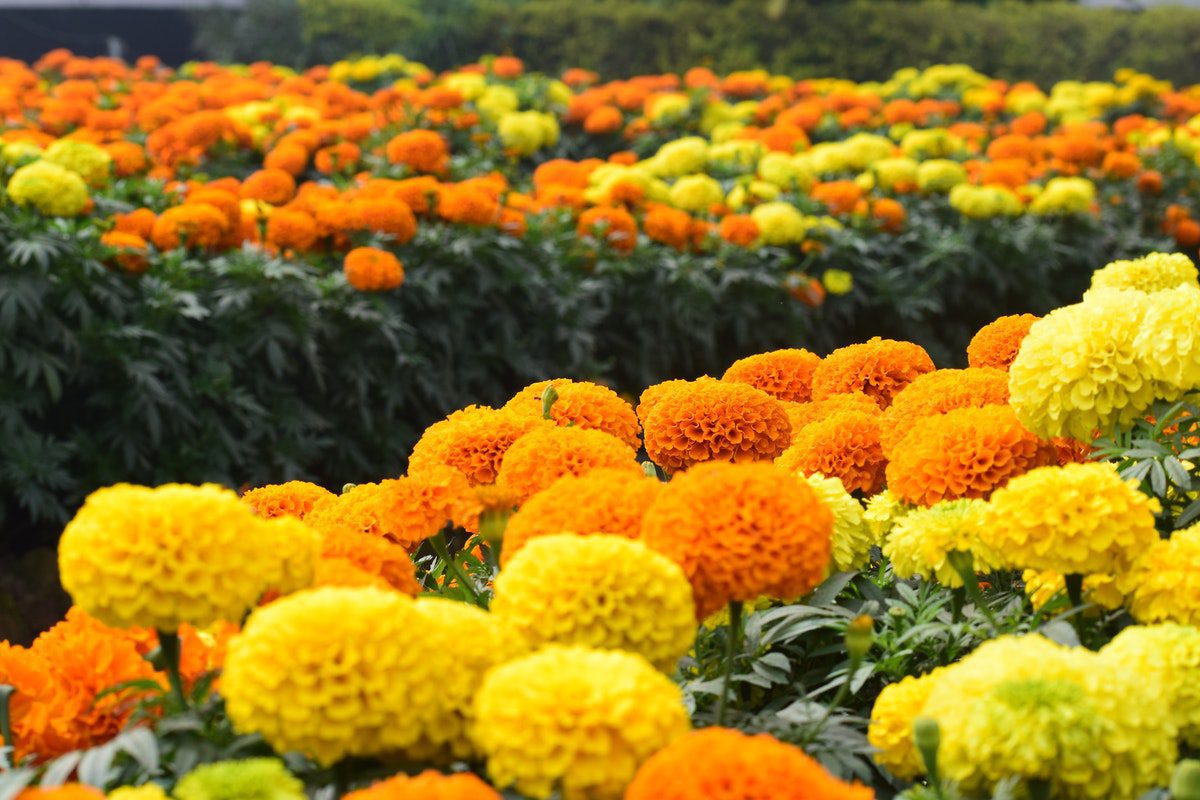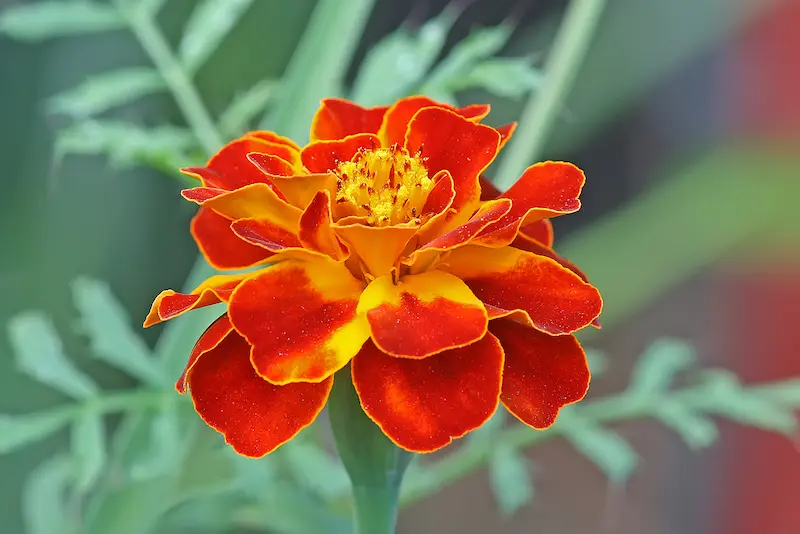How To Grow And Care For Marigold Flowers

The Marigold, botanical name Tagetes, is a joyful and easy-to-grow plant that is the first choice of people looking for a bright and beautiful natural show for their homes! Marigolds require little upkeep once planted and are pest-free. In fact, they are occasionally planted to keep pests away from other plants. Though considered by many as a summer bloomer, marigolds will bloom in spring and into fall if these are warm months in your area.
Marigold Flower Colours
Throughout the summer, marigolds bloom in a variety of vivid colours such as yellow and orange, maroon, gold, crimson, and dazzling sprays of multicoloured brass, copper, and gold flowers; let’s not forget the white french vanilla marigold. The plants range in height from 6 inches tall (Signet Marigolds) to 2 or 3 feet tall (African Marigolds). Daisy-like or carnation-like heads can be seen alone or in densely packed ball-like clusters.
Quick Growing Guide
Botanical Name: Calendula officinalis, Tagetes tenuifolia and many more
Genus: Tagetes
En français: Fleur de souci
Blooms:
Sun / Shade:
Watering:
Height:
Width:
Care:
Tagetes should not be confused with Marsh Marigold.
Are Marigolds Edible?
Marigold petals, which are edible and delicious, have been a well-known culinary flower since ancient times. Citrus marigold flowers feature zesty and lemony flavours reminiscent of orange soda and dazzling tangerine, whilst French marigold flowers have dusky orange flavours and a great texture, making each edible petal quite enticing. African marigolds (Tagetes erecta) produce edible flowers, although the strong fragrance is often avoided.
Marigolds can be eaten raw or blanched, fresh or dried, sweet or savoury, as petals or leaves.
Prepare Marigolds: Pull complete petals from the stem and, while holding them firmly in your palm, cut off the white (or light greenish) “heels” with scissors, since they might offer a harsh flavour.

How To Care For Marigold Flowers
The Marigold plant is a no-fuss, easygoing flower which adds a lot of colour to your life. It grows very beautiful and exceedingly joyful flowers throughout the summer till the first frost of the autumn season. Marigolds bloom and flourish in plant hardiness zones 2 to 11. Because of their hardiness, they may be planted practically anyplace and will flourish with little to no assistance.
Plant marigolds in areas with plenty of heat and sunshine for the best-looking blooms, though they tolerate partial shade. They will flourish even if put near paved surfaces, as long as you remember to water them.
Plant marigold flowers in flower gardens among other brightly coloured perennials and annuals. Growing marigolds in pots allows them to grow in ordinary soil and even survive in bad soil conditions!
Don’t overwater or fertilise them, otherwise the plants will produce too many leaves instead of the lovely blossoms.
Marigold Blooms
Marigolds can bloom for several months, peaking in the summer and continuing into the fall. They have a shorter bloom period in zones 8 and lower, when temperatures fall below freezing earlier in the season, and a longer bloom period in zones 10 and above, where temperatures fall below freezing later in the winter. Marigolds can be cultivated in hardiness zones 2 through 11.
How To Plant Marigold Seeds
Plant marigold seeds in your garden when weather is warm or sow seed into pots approximately 4 to 6 weeks before the last spring frost arrives. Cover marigold seeds with ¼ inch of soil. Marigold seeds germinate easily but watch out for damping off issues as they grow. Separate marigold seedlings when they reach about 2 inches. [embedded content]
Marigolds do not require special soil, however many gardeners advocate using a potting mix when growing them in containers. Use loose soil while planting, whether in the garden or in containers. Tall marigolds should be planted about 2 feet apart, while smaller varieties should be planted around 1 foot apart.
Pruning Marigolds
Marigold plants do not require extensive pruning, however deadheading help the plant to blooms and discourages seeding. When pruning, look for any dead flowers on the plant and pick them off with your fingertips. Healthy marigold flowers will sprout with new growth quickly!
Marigold Pest Control
Marigold flowers are excellent plants for natural pest control.
The natural aroma of the Marigold plant repels a variety of insects and small animals from your yard. It also generates alpha-terthienyl, which aids in the elimination of root-knot nematodes. It keeps damaging microscopic nematodes and other pests at bay for many years. More precisely, by incorporating marigolds into the mix, you may safeguard your valuable other plants from deer.
Marigolds are not completely resistant to pests; white and green aphids, as well as sap-sucking spider mites, have been known to take a like to the marigold plant. In most cases, a short spray of water mixed with insecticidal soap or neem pesticide spray oil would eliminate the infestation problem. Apply once a week until the bugs have been eliminated. During the rainy season, slugs may find your Marigolds appealing, but there’s nothing a little slug repellant can’t remedy!
Varieties
Of the 50-odd marigold plant species, but the most popular varieties include:
Signet Marigold
In signets and rock gardens, the delicate Tagetes tenuifolia, often known as the signet marigold, thrives. It may reach a height of 12 inches. This plant prefers arid environments and is excellent for landscaping edging. The blossoms of Tagetes tenuifolia are edible to humans. In addition, unlike other types with a strong odour, they provide gardeners with season-long blooms of fragrant flowers and even leaves. Tagetes tenuifolia is also easy to cultivate, resistant to deer and rabbits, and drought tolerant.
French Marigold
The French Marigolds (Tagetes patula) are distinguished by their bushy, compact stature. Don’t be fooled; tagetes patula’s exquisite, tiny, modest blooms and plants may grow anywhere from 6 inches to 2 feet tall. French marigolds need full light and well-drained soil to thrive. They should be placed deeper than the bedding container and six to nine inches apart from the other seeds of French marigolds.
Desert Marigold
The desert marigold, famed for its daisy-like flower petals, can grow from a few inches to a foot tall. Although it is a short-lived perennial, this yellow flowering plant produces a large number of marigold seeds.
White Marigold
French vanilla, often known as white marigold, varies from the more common yellow and orange-bearing marigold plants. Its pure-colored blossoms can grow to be up to 3 inches wide.
Pot Marigold or Calendula
Pot marigold or calendula has beautiful yellow, gold, and orange blossoms. Calendula’s citrus-flavored blossoms are used to produce marigold tea and also as a component in culinary preparations. You may use them in salads, sandwiches, and even seafood. Calendula petals may also be used to give colour to rice meals.
African Marigold
Tagetes erecta, sometimes known as African marigold, is the tallest of the Marigold group of plants, with plants ranging in height from 3 to 5 feet. African marigolds are also known as American marigolds and Aztec marigolds. The African marigold blooms with bigger flowers. Among other well-known species, such as French marigolds, Tagetes erecta is more drought resistant, prefers full light, and appears to prefer poor soil.